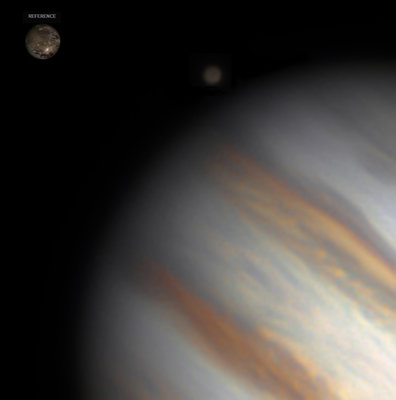by barretosmed » Tue Apr 28, 2020 5:56 pm
GANYMEDE
It was the first time that I got some detail on Jupiter's moons, I did a processing of a unique video, focused only on the natural satellite, so the image of Jupiter doesn't come out very well, but I preferred to leave it like that rather than make composition.
I got the focus right and also the day.
Ganymede discovered by Galileo Galilei, is the main natural satellite of Jupiter, being bigger than the planet Mercury.
xX The image in its upper left corner is just a reference image Xx
More details:
https://www.astrobin.com/full/ru1j37/0/ ... real=&mod=
Equipment
MEADE LX200 10 "UHTC
ZWO Optical ASI 290 MC
Filter: Baader Planetarium L 1.25 "
Accessory: TeleVue Powermate 2.5x
Software:
Photoshop CS6, SharpCap V3.0 Sharcap, AutoStakkert AutoStackert !, Registax 6,
April 26, 2020
Sao Paulo-SP-Brazil
Copyright: Fernando Oliveira de Menezes
- Attachments
-

[size=120][b] GANYMEDE[/b][/size]
It was the first time that I got some detail on Jupiter's moons, I did a processing of a unique video, focused only on the natural satellite, so the image of Jupiter doesn't come out very well, but I preferred to leave it like that rather than make composition.
I got the focus right and also the day.
Ganymede discovered by Galileo Galilei, is the main natural satellite of Jupiter, being bigger than the planet Mercury.
xX The image in its upper left corner is just a reference image Xx
[b]More details:[/b]
https://www.astrobin.com/full/ru1j37/0/?nc=Fernando_Menezes&real=&mod=
[b]Equipment
[/b]MEADE LX200 10 "UHTC
ZWO Optical ASI 290 MC
Filter: Baader Planetarium L 1.25 "
Accessory: TeleVue Powermate 2.5x
[b]Software[/b]:
Photoshop CS6, SharpCap V3.0 Sharcap, AutoStakkert AutoStackert !, Registax 6,
April 26, 2020
Sao Paulo-SP-Brazil
Copyright: Fernando Oliveira de Menezes
[img2]URL to image file (which must be to the image itself)[/img2]